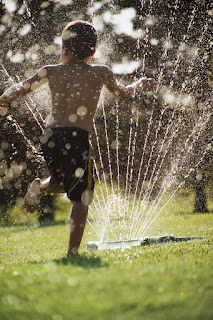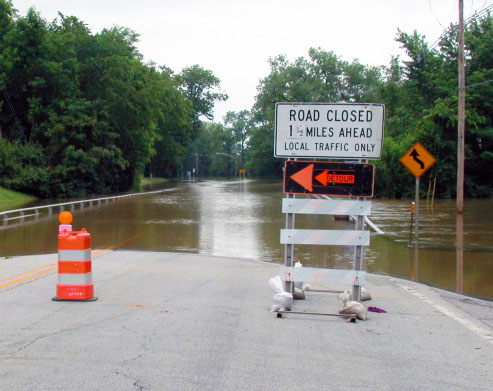Category:
Lawn to Lake works with Chicago community
October 1st, 2015 by iisg_superadminUrban flooding a timely issue at upcoming Resilient Chicago workshop
June 8th, 2015 by iisg_superadminEnough rain fell in Texas over the past month to cover the entire state in more than eight inches of water. The Trinity River in Dallas has risen to levels not seen in over 25 years. Flooding has resulted in $45 million worth of damage in Houston alone, and at least 31 people have died, with 10 still missing. As recovery in the Lone Star State begins, it becomes clear just how important urban flood management is, not only for the safety of people, but for the health and well being of the environment. Next month, Chicago, no stranger to flooding itself, will be the host location to a workshop confronting these very issues.
The two primary foci of the workshop will be how to apply No Adverse Impact (NAI) floodplain management and integrating green infrastructure into comprehensive and capital improvement planning. By focusing on NAI floodplain management, the workshop will provide potential management solutions that can be applied from strictly flooding related problems to issues like water quality protection and stormwater management. And in showcasing the potential for green infrastructure, attendees will learn how to cope with the increased potential for soil saturation that comes with urban development. The workshop will be sponsored by ASFPM, and the NOAA Coastal Storms Program.
.
It’s no longer guesswork in the Chicago region to get the price of water right
May 27th, 2015 by iisg_superadminWhen municipalities consider how to set water rates, they often look to neighboring communities as reference points. This can involve a lot of digging for data, which takes lots of time, and in the end, may be comparing apples with oranges.
The water rate dashboards include dials showing comparative measures of average monthly bills, affordability, how well rates cover operation and maintenance costs, and the level of conservation that is encouraged.
Breaking news: Michigan City buoy returns for fourth season
April 28th, 2015 by iisg_superadminThe trouble with aquaponics
April 6th, 2015 by iisg_superadmin As its name suggests, aquaponics is a a combination of aquaculture and hydroponics. Like with hydroponics, plants are grown with their roots directly in water. But where hydroponics introduces necessary nutrients artificially, aquaponics takes advantage of a symbiotic relationship between aquatic animals, bacteria, and plants. Normally aquaculture tanks need to be filtered to prevent waste byproducts from reaching harmful levels, but with aquaponics, bacteria convert these byproducts into the necessary nutrients for healthy plant growth. The plants are fed, and the water is filtered.
As its name suggests, aquaponics is a a combination of aquaculture and hydroponics. Like with hydroponics, plants are grown with their roots directly in water. But where hydroponics introduces necessary nutrients artificially, aquaponics takes advantage of a symbiotic relationship between aquatic animals, bacteria, and plants. Normally aquaculture tanks need to be filtered to prevent waste byproducts from reaching harmful levels, but with aquaponics, bacteria convert these byproducts into the necessary nutrients for healthy plant growth. The plants are fed, and the water is filtered.
Website of the week: Tour Chicago’s lakefront from the comfort of home
December 10th, 2014 by iisg_superadminA closer look at web tools and sites that boost research and empower Great Lakes communities to secure a healthy environment and economy.
It’s getting a little chilly for a stroll in the Windy City, but don’t let that stop you from enjoying it’s beautiful downtown lakefront. With Chicago Water Walk, you can explore some of the city’s most celebrated sites—Navy Pier, the Chicago River, downtown marinas, Buckingham Fountain, and Museum Campus—from anywhere.
The mobile-friendly website takes viewers on a journey through time to discover how Lake Michigan and the Chicago River transformed a small trading post into one of the economic and cultural hubs of the world—and the vital role these natural resources play in the city’s present and future.
Each stop in the virtual tour combines history, current events, and water sciences with fun facts to show the importance of aquatic ecosystems in the city’s past, present, and future. Stunning photos, historical images, and links to videos and other resources bring these issues to life and reveal a lakefront that will surprise even lifelong Chicagoans.
Visit the website and you’ll learn why the decision to reverse the Chicago River is still making waves more than a century later, how a city that sits along Lake Michigan can be concerned about having enough water in the future, and how native trees and plants are helping the city prepare for changing weather patterns. You’ll also hear about efforts to restore much-needed habitats for millions of birds, fish, and other wildlife.
And for those willing to brave the cold, a mobile tour app is available for free on Apple devices. You can follow the suggested routes or visit the sites that most appeal to you using the app’s interactive map.
The Chicago Water Walk website and app were developed by Illinois-Indiana Sea Grant with funding from the Illinois Department of Natural Resources Coastal Management Program and technical support from the University of Illinois Administrative Information Technology Services.
Resilient Chicago highlights the many faces of climate change
October 9th, 2014 by iisg_superadmin Anjanette Riley was at last week’s Resilient Chicago workshop on climate trends and adaptive planning. She had this to say about the event:
Anjanette Riley was at last week’s Resilient Chicago workshop on climate trends and adaptive planning. She had this to say about the event: Former intern Ada Morgan continues work on environmental issues
August 26th, 2014 by iisg_superadmin.jpg) We recently got some exciting news from former intern Ada Morgan, who in 2011 worked with Caitie McCoy on a study of community perceptions of sediment remediation in the Sheboygan River Area of Concern. We’ll let her tell you what she has been up to since.
We recently got some exciting news from former intern Ada Morgan, who in 2011 worked with Caitie McCoy on a study of community perceptions of sediment remediation in the Sheboygan River Area of Concern. We’ll let her tell you what she has been up to since.“The Sheboygan study finished up just before I graduated from the University of Illinois at Urbana-Champaign. I studied economics and environmental geology there, and I knew I wanted to continue my studies in the environmental field. I was encouraged by Caitie and a few others I looked up to to look into graduate school. That fall, I began a master of urban planning and policy program at the University of Illinois Chicago, where I continued to learn about how humans interact with our environment and how to think holistically about the decisions we make.
My specialization was in environmental planning. I took some great courses, like an economic and environmental planning course and a course on residential sustainability policy. My final project centered on greywater reuse in a south suburb of Chicago.
I graduated this past May and am now the environmental and sustainability coordinator for a bread manufacturing company. I started just a few weeks ago. I am responsible for both environmental compliance (permits, etc.) and sustainability projects and initiatives. My main task so far has been re-developing an environmental management system for the entire company, which has four different facilities.
My experiences working with Caitie at IISG was the best preparation I could have had for both graduate school and my current job. I was able to participate in almost all aspects of the Sheboygan study. I helped with interviewing stakeholders, performed data analysis, and co-authored the final report with Caitie. You don’t often get this kind of hands-on experience with qualitative analysis and reporting in school.
I also learned a lot about environmental regulations since the project I worked on was under EPA’s Great Lakes Legacy Act. Understanding the regulatory structure helped tremendously while I was in the urban planning program (reading codes) and continues to help me navigate compliance issues at my company. Overall, the time I spent at IISG was one of my most valuable internships, and I am extremely thankful to have had the opportunity to work at such a fantastic organization.”
Invasive but delicious: Chicago shop serves up Asian carp burgers
July 9th, 2014 by iisg_superadmin“Highly invasive Asian carp are advancing on the Great Lakes, so fire up your grill. Asian carp are eaten and appreciated globally, but the fish have never been popular in America because they’re bony and are thought to be bottom-feeders (actually, you can tell your pesca-prejudiced pals, Asian carp are plankton-feeders.) Nevertheless, Asian carp burgers at Dirk’s Fish & Gourmet Shop have been well-received.’90 percent of the people who try it like it,’ Dirk Fucik says. At Taste of Chicago one year, Fucik gave out 800 carp burgers in two hours.
Fucik fillets the carp, then grinds the remaining fish. ‘Once you’ve done that, it’s like ground anything,’ Fucik says. He’s used Asian carp in the meatballs in Italian wedding soup, and he’s received a lot of compliments for his Asian carp gefilte fish. Fucik recommends preparing his burgers with some cambozola cheese in the middle, or using Dirk’s Thai or ‘Terry-aki’ marinades. The burgers cost $6 per pound, compared to $18 a pound for salmon burgers.”
Recent News
- Tomas Höök signing off as Illinois-Indiana Sea Grant director this summer
- Illinois-Indiana Sea Grant welcomes Stuart Carlton as the program’s new director
- Four Illinois and Indiana educators will set sail on Lake Michigan aboard EPA’s research ship
- Join IISG as a new pollution prevention outreach assistant
- Beach season means it’s time for lifesaving Lake Michigan water safety resources
IISG Instagram
📢 Show Your Support for Sea Grant! 📢
Continued federal funding for Sea Grant in FY26 is crucial, and we need your help to demonstrate the nationwide support for these essential programs.
🖊️ Sign the letter urging Congress to continue funding Illinois-Indiana Sea Grant and all 34 state Sea Grant programs:
🔗 https://forms.gle/7sPGHGyh8j8a7vfGA or link in bio

Exciting news! The call for sessions for the 2026 Emerging Contaminants in the Environment Conference has been extended!
We are excited to offer the opportunity to propose a speaker or panel session during the 2026 Emerging Contaminants in the Environment Conference April 28-29. The conference will feature traditional 15-minute presentations and a poster session on the latest in emerging contaminant research, policies, and outreach in the soil, water, and air.
The deadline to propose a session is September 30, 2025.
Learn more at go.illinois.edu/ecec or the link in bio

Stay safe and have fun this Fourth of July with these 5 water safety tips! Click the link in bio to learn more ways to keep yourself and others safe as you enjoy the Lake Michigan beaches this holiday.

Four science educators from Illinois and Indiana have been selected for the 2025 Shipboard Science Immersion on Lake Michigan July 7-13. The educators will spend a full week alongside researchers aboard the EPA research vessel Lake Guardian. Afterwards, they will bring Great Lakes science back to their classroom.
Learn more and meet the four incredible teachers representing Illinois and Indiana at the link in bio.

Categories
- Aquaculture
- Aquatic Invasive Species
- Buoys
- Climate Ready Communities
- Director's Blog
- Education
- Featured
- Fellowships
- Fisheries
- Funded Research
- Funding
- Great Lakes Cleanup
- Great Lakes Data
- Healthy Waters
- Internships
- Jobs
- K-12 Education
- News
- Photos
- Program
- Recreation & Tourism
- Resources
- Sea Grant Scholars
- Stormwater & Green Infrastructure
- Sustainable Community Planning
- The Helm
- Uncategorized
- Video
- Water Resource Economics






